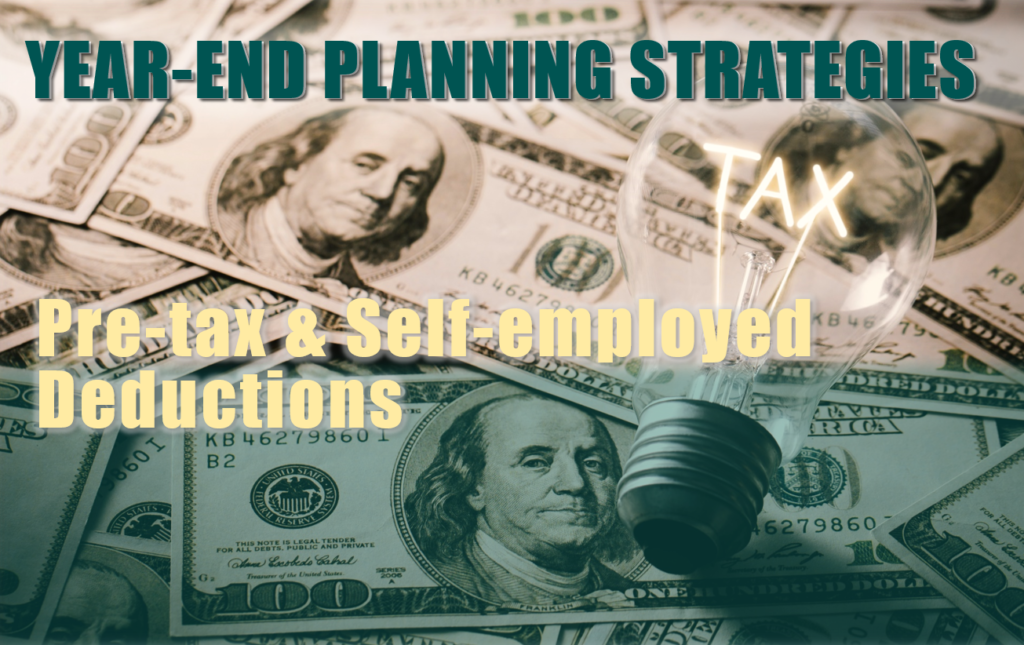With the end of 2022 coming closer and closer every day, you can help reduce your taxable income during the last month of the year with tax planning strategies. We will be posting a series of ideas to consider in order to minimize your tax liability. See the “Related Posts” link at the bottom of this article for more tax planning strategies.
Pre-Tax Employee Deductions
Retirement plans, such as a 401(k), Health Savings Accounts (HSA) and Flexible Spending Accounts (FSA) are vehicles that can be utilized to reduce an individual’s taxable wages and lower his/her federal tax liability. Individuals can make a tax-deductible annual contribution up to $20,500 to a 401(k), and those who are at least 50 years old can contribute an additional $6,500 per year (these limits increase to $22,500 & $7,500, respectively for 2023).
An HSA account allows taxpayers with high-deductible health plans (at least $1,400 for an individual and $2,800 for a family) to make tax-free contributions to the HSA and take tax-free distributions for qualified medical expenses. For the 2022 tax year, the maximum contribution amounts are $3,650 for individuals and $7,300 for family coverage ($3,850 for individuals and $7,750 for families in 2023). If you are 55 or older, you can add up to $1,000 more as a catch-up contribution. HSAs have no “use-it-or-lose-it” provision. Any funds remaining in the plan at the end of the year can be rolled over indefinitely.
Similar to an HSA, an FSA allows tax-free contributions and withdrawals for medical and dental services, for individuals who do not have high-deductible insurance (maximum contribution of $2,850 in 2022, and $3,050 in 2023). Similar transit and parking accounts for commuter benefits, also allow you to reduce your taxable income by paying for certain workplace transportation expenses on a tax-free basis through payroll deductions. Commuter benefits are not tied to a benefit year, and the funds remain in your account until they are spent. The maximum contribution per month (per each benefit) is $280 for 2022, and $300 for 2023.
Self-Employed Deductions
Self-employed individuals can also utilize retirement plan options to reduce self-employment income and lower their federal tax liability. One of these specialized plans is a Solo 401(k), which is designed for self-employed business owners without employees (exception is a spouse who works at least part time for them). Similar to a workplace 401(k), there are employer and employee contributions for solo 401(k) plans. For 2022, you can contribute up to 100% of your net adjusted self-employed income or $20,500 ($22,500 in 2023), whichever is less, as an employee. Then, as an employer, you can contribute up to 25% of your net adjusted self-employed income, up to a total account value of $61,000. For people who are 50 and older, a solo 401(k) allows an additional catch-up contributions as an employee, $6,500 in 2022, and $7,500 in 2023.
Two other types of retirement plans, a Simplified Employee Pension (SEP) plan and a Keogh plan, also provide tax advantages for self-employed individuals. A self-employed individual can contribute up to 25% of his/her earnings (up $61,000 each year) to a SEP or Keogh plan. SEP and Keogh plans allow self-employed individuals to continue to make tax-deductible contributions, which apply to their current-year returns, up to April 15.
Individuals may want to consider one of these tax ideas as part of a tax-saving strategy. Our tax professionals are available to help you evaluate your options and answer your questions. Please reach out to your GYF executive or contact our office at 412-338-9300 for assistance.
Related Posts
Year-End Tax Planning Strategies for Individuals – Bunching of Itemized Deductions
Year-End Tax Planning Strategies for Individuals – Securities








